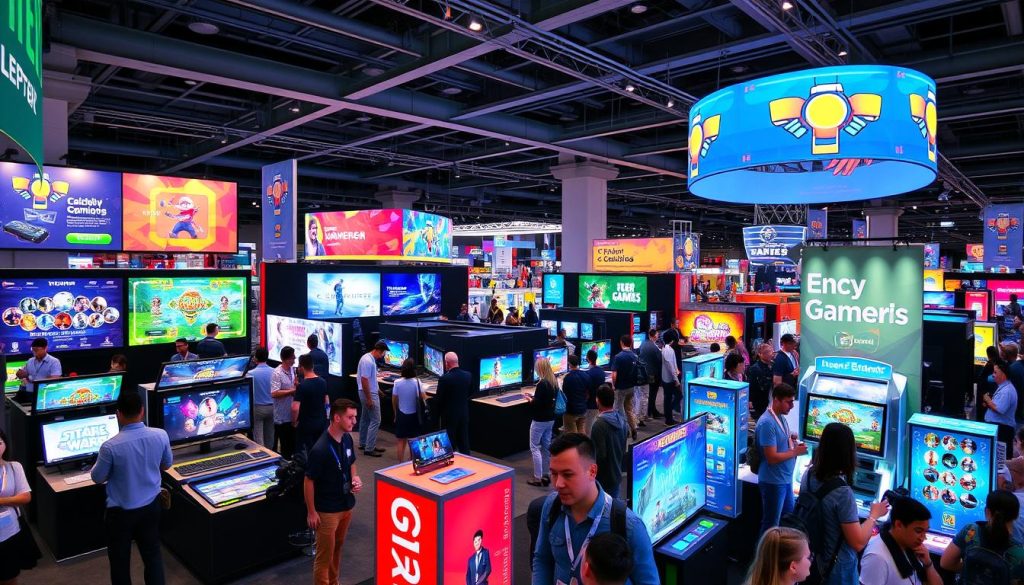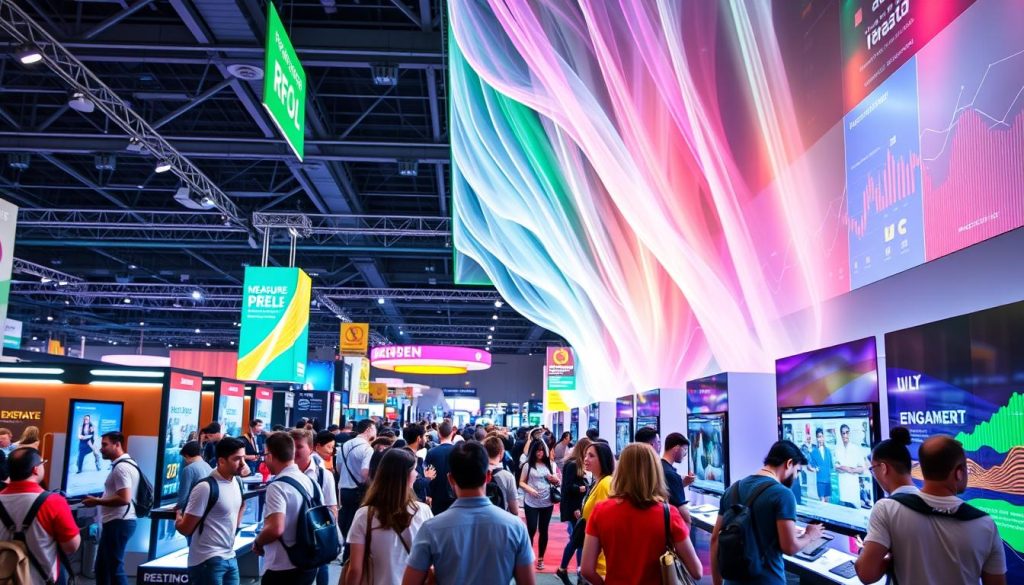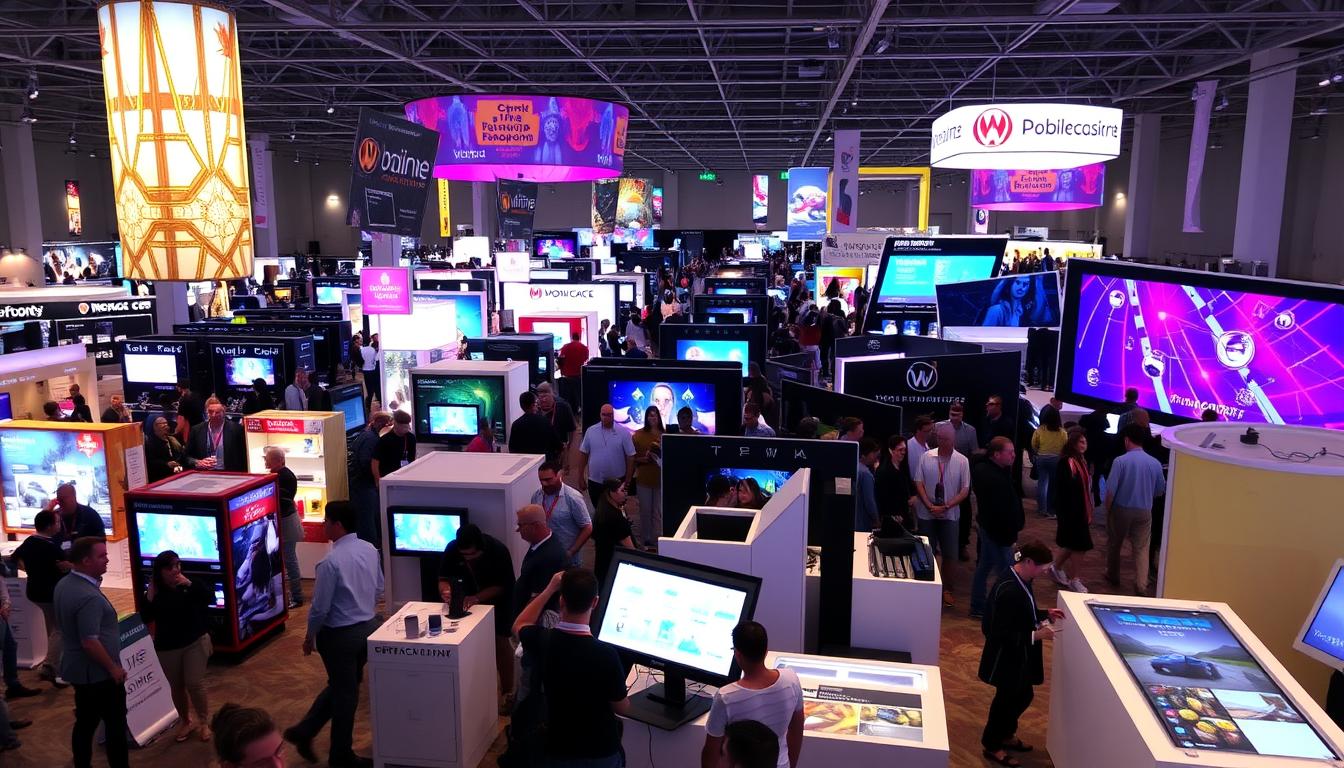Expos are prime opportunities for brands to shine. In today’s competitive landscape, creating a memorable expo experience is crucial. By harnessing the power of gamification and experiential marketing, companies can forge lasting connections with their audience. This guide explores innovative strategies to boost brand activation and audience engagement at your next expo.
From cutting-edge technologies to immersive games, we’ll uncover the secrets to crafting unforgettable brand experiences. These tactics not only captivate attendees but also drive meaningful interactions that resonate long after the expo ends. Get ready to transform your expo presence and leave a lasting impression on your target market.
Key Takeaways
- Gamification enhances audience engagement at expos
- Experiential marketing creates memorable brand interactions
- Interactive games drive meaningful connections with attendees
- Brand activation strategies boost expo presence
- Innovative technologies elevate the overall expo experience
- Memorable experiences lead to long-term brand loyalty
Creating a Memorable Expo Experience with Interactive Games
Interactive games transform expos into immersive experiences. By leveraging event technology, exhibitors can captivate attendees and leave lasting impressions. Game-based learning offers a unique way to engage visitors while conveying brand messages effectively.
Understanding Game Mechanics for Expo Settings
Expo games need to be quick, engaging, and easy to understand. Touch screens, motion sensors, and augmented reality can create intuitive interfaces. Challenges should be solvable within minutes, keeping lines moving and energy high. Popular mechanics include quizzes, puzzles, and virtual scavenger hunts.
Integrating Brand Messages into Interactive Experiences
Successful expo games seamlessly blend fun with brand education. Product features become game elements, company history forms the backdrop, and mascots guide players through challenges. This subtle approach ensures participants absorb key messages while enjoying the experience.
Measuring Success Through Engagement Metrics
Data drives improvement in interactive expo experiences. Key metrics include:
- Participation rates
- Average play time
- Social media shares
- Lead capture numbers
- Post-event survey scores
By analyzing these factors, exhibitors can refine their game designs and maximize ROI. Event technology provides real-time insights, allowing for on-the-spot adjustments to enhance engagement.
“Interactive games at expos aren’t just about entertainment. They’re powerful tools for brand communication and lead generation when designed thoughtfully.”
The Psychology Behind Successful Expo Engagement
Understanding the human mind is key to creating memorable expo experiences. Successful brand activation taps into core psychological principles that drive visitor behavior and decision-making. By leveraging these insights, companies can design immersive experiences that captivate attendees and leave lasting impressions.
One crucial aspect of audience engagement is the power of novelty. Our brains are wired to pay attention to new and unexpected stimuli. Expo organizers can capitalize on this by incorporating unique interactive elements that surprise and delight visitors. This could range from innovative product demonstrations to interactive messaging experiences that create personalized connections.
Experiential marketing thrives on emotional connections. When visitors feel emotionally invested in an experience, they’re more likely to remember it and associate positive feelings with the brand. Crafting narratives that resonate with your target audience can significantly enhance engagement and brand recall.
“The most effective expo experiences are those that create an emotional connection with visitors, turning a simple interaction into a memorable moment.”
Social proof is another powerful psychological tool. People tend to follow the actions of others, especially in unfamiliar environments like expos. Showcasing real-time participation metrics or featuring testimonials can encourage more visitors to engage with your exhibit.
| Psychological Principle | Application in Expo Setting | Impact on Engagement |
|---|---|---|
| Novelty | Unique interactive displays | Increased attention and curiosity |
| Emotional Connection | Storytelling and personalized experiences | Enhanced brand recall and loyalty |
| Social Proof | Real-time participation metrics | Boosted participation rates |
By integrating these psychological principles into your expo strategy, you can create a powerful brand activation that resonates with visitors long after the event ends. The key is to design experiences that align with human behavior and cognitive processes, ensuring maximum impact and engagement.
Essential Elements of Immersive Expo Experiences
Creating immersive experiences at expos requires careful planning and integration of various elements. By focusing on sensory engagement, space design, and cutting-edge event technology, exhibitors can captivate their audience and leave a lasting impression.
Sensory Integration Techniques
Engaging multiple senses enhances the overall expo experience. Consider these techniques:
- Visual stimulation through dynamic displays and lighting
- Interactive audio elements for ambient sound
- Tactile experiences with product demonstrations
- Scent marketing to evoke emotions and memories
Space Design and Flow Management
Effective space utilization is crucial for guiding visitors through your exhibit. Streamline event management by implementing smart design principles:
- Create clear pathways for easy navigation
- Use zones to separate different activities or product lines
- Incorporate rest areas for comfortable audience engagement
Technology Integration Points
Leverage event technology to create interactive touchpoints throughout your exhibit:
| Technology | Application | Benefit |
|---|---|---|
| Touchscreen Displays | Product Information | Self-guided exploration |
| RFID Wristbands | Visitor Tracking | Personalized experiences |
| AR Mobile Apps | Virtual Product Demos | Enhanced engagement |
By combining these essential elements, exhibitors can create truly immersive experiences that captivate attendees and drive meaningful interactions at expos.
Virtual Reality Applications for Modern Expos
Virtual reality is transforming the expo landscape, offering immersive experiences that captivate attendees. This cutting-edge event technology opens new doors for engagement and product showcasing.
VR Gaming Stations Setup
Setting up VR gaming stations at expos creates a buzz and draws crowds. These interactive zones let visitors dive into virtual worlds, trying out products or services in a fun, game-like environment. The key is to align the games with your brand message for maximum impact.
Mixed Reality Experiences
Mixed reality blends the physical and digital worlds, offering unique expo experiences. Attendees can interact with virtual objects in real space, creating memorable moments. This technology allows for creative product demonstrations and immersive brand storytelling.
Virtual Product Demonstrations
Virtual product demos take presentations to the next level. They allow expo visitors to explore products in detail, even those too large or complex for physical display. This approach is particularly effective for industries like automotive, aerospace, and architecture.
To create effective virtual reality experiences, consider these factors:
| Factor | Importance | Considerations |
|---|---|---|
| Hardware Quality | High | Use latest VR headsets for best visuals |
| Content Relevance | Critical | Align VR content with brand message |
| User Comfort | Essential | Ensure easy-to-use interfaces, brief sessions |
| Technical Support | Vital | Have staff ready to assist and troubleshoot |
By leveraging virtual reality, expos can create unforgettable experiences that leave lasting impressions on attendees.
Augmented Reality: Bridging Digital and Physical Spaces
Augmented reality (AR) is revolutionizing the expo landscape, creating a seamless blend between digital content and physical environments. This cutting-edge event technology opens up new possibilities for engaging attendees and showcasing products in innovative ways.
AR enhances product displays by overlaying digital information onto physical objects. Visitors can point their smartphones at a product to view 3D models, specifications, and interactive demos. This creates immersive experiences that captivate audiences and leave lasting impressions.
Interactive AR games and activities add an element of fun to expos. Scavenger hunts using AR markers scattered throughout the venue encourage exploration and increase engagement. Virtual photo booths allow attendees to take pictures with digital props and share them on social media, expanding the event’s reach.
“Augmented reality transforms passive observers into active participants, creating memorable interactions that drive brand awareness and lead generation.”
To implement AR effectively, consider these key factors:
- User-friendly apps that work across multiple devices
- Clear instructions for attendees on how to access AR features
- Strong Wi-Fi infrastructure to support high-bandwidth AR applications
- Integration with other event technologies for a cohesive experience
By harnessing the power of augmented reality, expos can create truly immersive experiences that blur the lines between digital and physical realms. This technology not only enhances engagement but also provides valuable data insights, helping exhibitors measure ROI and refine their strategies for future events.
Gamification Strategies for Maximum Engagement
Gamification has revolutionized audience engagement at expos. By incorporating game elements into brand experiences, companies can boost interaction and create lasting impressions. Let’s explore effective strategies to maximize engagement through gamification.
Point Systems and Rewards
Point systems are the backbone of gamification. Visitors earn points for various activities, from booth visits to product demonstrations. These points can be redeemed for prizes, creating a sense of achievement and encouraging further participation. A well-designed reward system can significantly increase brand activation efforts.

Competition Elements
Friendly competition drives engagement. Leaderboards displayed at your booth can spark a desire to climb the ranks. Challenges and quests related to your products or services encourage exploration and learning. By fostering a competitive spirit, you create memorable experiences that resonate with attendees long after the expo ends.
Social Media Integration
Integrating social media amplifies your expo presence. Encourage visitors to share their experiences using branded hashtags. Create photo opportunities or virtual reality experiences that attendees want to post about. This not only extends your reach but also provides valuable user-generated content for future marketing efforts.
| Gamification Element | Engagement Impact | Implementation Difficulty |
|---|---|---|
| Point Systems | High | Medium |
| Leaderboards | Medium | Low |
| Social Media Challenges | Very High | Low |
| VR Experiences | Very High | High |
By leveraging these gamification strategies, you can create an immersive and interactive expo experience that drives audience engagement and leaves a lasting impact on attendees.
Technology Infrastructure for Interactive Exhibits
Setting up interactive exhibits at expos demands a robust technology infrastructure. Event technology plays a crucial role in creating engaging experiences for attendees. Let’s explore the key components needed to power these interactive displays.
Hardware Requirements
Interactive exhibits rely on cutting-edge hardware to function smoothly. High-performance computers, touch-screen displays, and motion sensors form the backbone of these setups. For virtual reality experiences, powerful VR headsets and controllers are essential. Augmented reality applications often require tablets or smartphones with advanced cameras and processors.
| Hardware Type | Purpose | Examples |
|---|---|---|
| Computers | Process data and run software | High-end gaming PCs, workstations |
| Displays | Showcase interactive content | 4K touchscreens, LED walls |
| VR Equipment | Immersive experiences | Oculus Quest, HTC Vive |
| AR Devices | Overlay digital content | iPad Pro, Microsoft HoloLens |
Software Solutions
The right software brings interactive exhibits to life. Custom applications, game engines, and content management systems are vital for creating and managing interactive content. Virtual reality software enables immersive 3D environments, while augmented reality platforms allow for seamless blending of digital and physical worlds.
Backup Systems
Reliability is key for successful interactive exhibits. Backup power supplies, redundant servers, and offline modes for critical applications ensure uninterrupted operation. Regular data backups and cloud-based solutions provide additional layers of protection against technical glitches or data loss.
By carefully considering hardware, software, and backup systems, exhibitors can create memorable interactive experiences that showcase the power of event technology, virtual reality, and augmented reality.
Measuring ROI Through Interactive Experiences

Quantifying the return on investment (ROI) of interactive expo experiences is crucial for brand activation success. By tracking key performance indicators, businesses can gauge the effectiveness of their experiential marketing efforts and justify their investment in audience engagement strategies.
To measure ROI, start by setting clear goals for your interactive experiences. These might include:
- Number of booth visitors
- Lead generation
- Social media mentions
- Product demo requests
- Post-event survey responses
Collect data using various methods such as digital check-ins, QR code scans, or follow-up emails. This information helps quantify the impact of your experiential marketing initiatives.
Analyze the gathered data to determine the ROI of your interactive experiences. Compare the costs of creating and implementing these experiences against the value of leads generated, increased brand awareness, and potential sales.
| Metric | Calculation Method | Target Value |
|---|---|---|
| Cost per Lead | Total Expo Cost / Number of Leads | $50 or less |
| Engagement Rate | (Interacted Visitors / Total Visitors) x 100 | 70% or higher |
| Social Media Reach | Sum of Impressions Across Platforms | 100,000+ |
By consistently measuring and analyzing these metrics, you can refine your audience engagement strategies and maximize the impact of your brand activation efforts at future expos.
Staff Training for Interactive Game Management
Successful interactive game management at expos hinges on well-trained staff. Equipping your team with the right skills ensures smooth operations and enhances audience engagement. Let’s explore key areas of focus for staff training in event technology and game-based learning.
Customer Service Excellence
Train staff to greet visitors warmly and explain game rules clearly. Teach them to handle questions patiently and assist participants of all skill levels. Role-playing exercises can help staff practice these skills in various scenarios.
Technical Troubleshooting
Equip your team with basic technical know-how. They should be able to reset games, adjust settings, and solve common issues quickly. Create a troubleshooting guide for staff to reference during the expo.
Engagement Facilitation
Staff should learn techniques to boost participation and maintain excitement. Teach them to encourage friendly competition, celebrate achievements, and keep energy levels high throughout the event.
“The key to successful game-based learning is not just in the technology, but in the human touch that guides and encourages participants.”
By focusing on these areas, your staff will be prepared to deliver an unforgettable interactive experience. Remember, the human element is crucial in making event technology truly shine and maximizing audience engagement.
Budget Planning for Interactive Expo Elements
Planning your budget for interactive expo elements can be exciting and challenging. Event technology like virtual reality and augmented reality can make your booth stand out, but they come with costs. It’s crucial to balance your vision with financial realities.
Start by listing must-have features and nice-to-have extras. Virtual reality experiences might be pricey, but they can draw big crowds. Augmented reality apps can be more budget-friendly while still engaging visitors. Don’t forget to factor in costs for game development, equipment rental, and extra staff training.
Remember, effective marketing strategies aren’t always the most expensive. Sometimes, simple interactive games can be just as effective as high-tech solutions. Consider your audience and goals when allocating funds. With smart planning, you can create an unforgettable expo experience without breaking the bank.
Lastly, always set aside a portion of your budget for unexpected expenses. Technology can be unpredictable, so having a cushion will help you handle any last-minute issues. By carefully planning your budget, you’ll be ready to wow attendees with an interactive and memorable expo presence.






